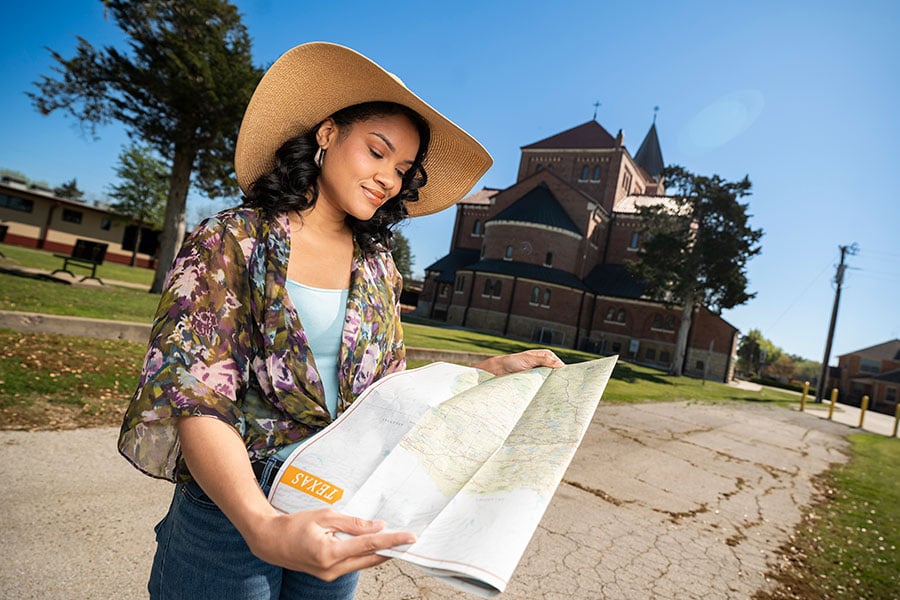Walk of faith: pilgrims sacrifice time and comfort to receive God’s grace

photo illustration/Juan Guajardo
New destinations, new sights, and new experiences — but it’s not a vacation.
It’s a pilgrimage.
Father Mel Bessellieu, parochial vicar of St. Francis of Assisi Parish in Grapevine, has led several pilgrimages to the Holy Land and religious shrines in the U.S. and abroad.
He explained the difference between a vacation and a pilgrimage in simple terms. “A vacation is all about you. You expect to receive a nice hotel room, nice food, and all of that. But on a pilgrimage, it’s more about giving to God — your heart, your mind, your soul. And let Him fill you with the graces that come,” he said.
A pilgrim journey has helped many diocesan Catholics in their walk of faith.
Olivia Olvera, the youth and family ministry director of St. Mary Parish in Graham, has experienced graces from making pilgrimages, including her trip to World Youth Day in Spain in 2011, where she first encountered “the big vision of the universal Church.”
She wants others to have a similar opportunity, so she’s organized parishioners from four local parishes to travel together to the National Eucharistic Congress in Indianapolis on July 17-21.
The National Eucharistic Congress, last held in 1941, expects tens of thousands of Catholics from across the country to gather for Masses, Adoration, workshops, and a revival each evening centered around Christ’s true presence in the Holy Eucharist.
The Department of Evangelization and Catechesis for the diocese is offering discounted tickets to the Congress.
When Olvera decided to go, she invited the adult faith formation group at St. Mary to join her. Twenty-six accepted, including some who have never traveled outside of Texas.
Olvera has big expectations, which will include a stop en route at the Blessed Stanley Rother Shrine in Oklahoma City.
She said, “All of us centered around the Eucharist is what gives life to the Church.
“I know that God transforms hearts, so I really do hope all of those who are going will encounter Him, that we are headed to encounter Him in the Eucharist. I do hope we all see the fruits of that, so we are able to carry it back to our community,” she continued.
Proven practice
The act of pilgrimage is ancient. Fourth-century accounts depict Christians traveling to sacred places to worship and venerate relics.
The desire to draw close to God through a physical journey is innate to the human condition, said Jason Whitehead, director of evangelization and catechesis for the diocese.
Because a person is both body and spirit, and not a disembodied soul, the “extra physicality of worship and pilgrimage very much fits within that frame,” he explained.
“We as Catholics know that we are supposed to unify, unite ourselves to Christ. And that’s not a mere mental act, but something we actually physically participate in,” he said.
United with Christ, we may experience redemptive suffering as pilgrims, he said. Pilgrimages are “painful, very often,” recalled Whitehead, who experienced long days of 14-mile walks and cramped accommodations as he accompanied 240 teenagers to World Youth Day in Poland in 2016.
“It challenges you to remain prayerful,” he said.
The Way
Many consider the ultimate pilgrimage to be the ancient El Camino de Santiago, the Way of St. James. For more than 1,000 years, pilgrims have begun at various locations in Spain, Italy, Portugal, France, or beyond and walked to the Cathedral of Santiago de Compostela in Galicia, Spain, where the bones of the Apostle James are entombed.
Among the 442,073 pilgrims who arrived at the cathedral in 2023 was Beth Kwansy, a parishioner of St. Jerome Parish in Bowie and a board member of Catholic Charities Fort Worth. She walked 188 miles from Porto, Portugal, to the Cathedral of Santiago de Compostela last June with her brother.
The 15-day journey was a chance to savor solitude, “unplug from the internet and work,” and devote time to her relationship with her brother and her faith.
Upon reaching their destination, Mass at the cathedral and seeing St. James’ tomb was “pretty spectacular,” she recalled, and said the pilgrimage gave her “a renewed sense of peace.”
A closer walk
Although a pilgrimage often calls to mind a long journey, “a pilgrimage isn’t always about the walking,” said Whitehead.
Instead, “it’s about the sacrifice one undergoes for the sake of [worship], because ultimately that’s what growth and holiness always boils down to. Pilgrimage, regardless of whether you’re on foot, bus, plane, whatever — if you go with a proper open heart, the Lord will find you.”
Two chief benefits result, he said. First, the soul expands, enabling the pilgrim to receive the second benefit: “actual grace, which even further moves the soul to being more widely disposed to the reception of sanctifying grace in the sacraments.”
Fr. Bessellieu said having a priest available on a pilgrimage to celebrate the sacraments — Mass at a holy site, reconciliation, and anointing the sick — “galvanizes [the pilgrim’s] faith just a little bit more.
“Every time we go to those places, people are just overwhelmed, and their faith is renewed. People have come up to me in tears saying, ‘Thank you, Father, for bringing us to these places, because it’s a place where you can touch God in a special way, and He can touch you back.’”
One more difference between a vacation and a pilgrimage is in the preparation. When planning a trip, vacationers often ready themselves with Yelp reviews, recommendations from friends, and guidebooks.
Before a pilgrimage, Whitehead recommends prayer, fasting, and almsgiving.
Fr. Bessellieu advised, “Don’t come with expectations. Just come with an open heart and an open mind to see God wants to do for you.”
